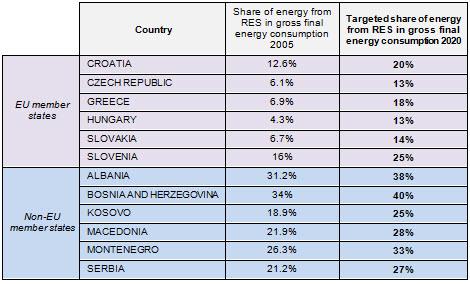AU SOMMAIRE
Focus on the energy sector
Editorial | Promotion of renewable energy sources in EU and non-EU countries of the SEE region
Bosnia and Herzegovina | Increasing investments in energy projects in BIH encouraged by the EU financial support
Croatia | Overview of the legal framework for electricity production from renewable energy sources
Czech Republic | Major changes in subsidies for renewable energy sources
Greece | Challenges faced on the electricity market - measures taken regarding photovoltaic stations | Restructuring of the wholesale electricity market
Montenegro | Use of energy from renewable sources - development and potential
Slovakia | Cheap gas in Slovakia thanks to State monopoly?
Slovenia | Investment opportunities in the energy sector
Business Insight
Macedonia | Foreign direct investments in Macedonia - the courting of foreign companies
Serbia | Serbia on the path of political and economic recovery - new wave of economic reforms
Slovenia | New act on taxation of real property and effects on the business environment
Cliquez sur la version PDF ci-dessous pour lire le dernier numéro de notre newsletter South-East Europe.
_______
Promotion of renewable energy sources in EU and non-EU countries of the SEE region
One of the current European Union headline goals is the promotion of energy from Renewable Energy Sources (“RES”). The Directive 2009/28/EC on the promotion of the use of energy from renewable sources establishes a common framework for the promotion of energy from renewable sources in the EU. It also sets mandatory national targets for the overall share of energy from renewable sources in gross final consumption of energy and for the share of energy from renewable sources in transport.
According to this Directive, each EU member state, including those in South-East Europe (Croatia, Czech Republic, Greece, Hungary, Slovakia, Slovenia) is required to increase the share of energy from renewable sources to a certain target percentage of its gross final energy consumption by 2020.
As members of the Energy Community, non-EU countries in the South East Europe region (Albania, Bosnia and Herzegovina, Kosovo, Macedonia, Montenegro and Serbia) are subject to the same rules and objectives. Indeed, by signing the Treaty Establishing the Energy Community on 25 October 2005, they agreed to implement the acquis communautaire on electricity, gas, environment, competition and renewables to create a regional gas and electricity market within South East Europe.
Thus, in the SEE region, both EU and non-EU countries are putting in place a national legal framework - further detailed in this Newsletter - to comply with the targets set out below:

The European Union has not only set targets, it is also providing significant means to support the countries of the SEE region in achieving these goals. For instance, the Western Balkans Sustainable Energy Efficiency Facility II (“WeBSEFF II”), a large-scale 75 million euro project, is being launched this year to provide credit lines to local banks in Albania, Bosnia and Herzegovina, Croatia, Macedonia, Kosovo, Montenegro and Serbia.
This framework should ensure an effective allocation of funds through the EBRD, which grants loans to local banks, these local banks in turn granting funds to investors in the energy sector. In line with the WeBSEFF I launched in 2009, which allowed the funding of 123 new energy efficiency and renewable energy projects, WeBSEFF II should further contribute to maximizing the energy-saving potential and opening up new markets in the SEE region.
Special focus is given throughout this Newsletter to the dynamics of the energy market in the SEE region. While the promotion of RES has led to the development of a specific legal framework and created investment opportunities in Croatia, Greece, Montenegro and Slovenia, concern over high energy prices also represents an important change factor on the energy market in the Czech Republic and Slovakia. In addition, this issue will also present relevant recent developments and challenges relating to the business environment in Macedonia, Serbia, and Slovenia.







